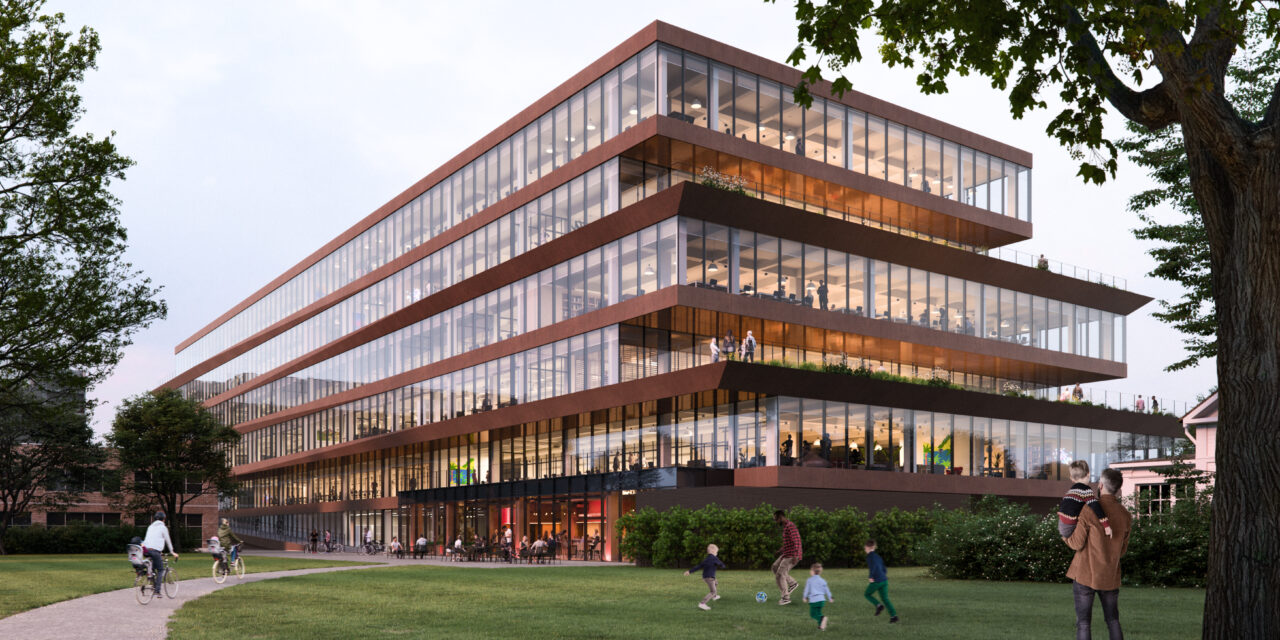How do you design an office building that incorporates the biking infrastructure of a community?
How do you build a structure that honors the art culture of the city?
How do you create a diverse office space that is also accessible to the public?
What if you could ride your bike to the door of your fifth-story office?
What would a bikeable building look like?
Just blocks from Bentonville’s town square, in the heart of the city’s best offerings of food, recreation and art, a six-story office space is being constructed. Ledger is a state-of-the-art structure that is anything but a conventional office building. Its purpose is to meet Bentonville’s increasing demand for flexible work space, but the inspiration behind it comes from the culture that has been created there.
“The idea emerged from answering questions and looking at the specificity of the place,” said Marlon Blackwell of Marlon Blackwell Architects, the architect of record for Ledger. “Looking outside the box of how you make a new development become part of the larger network of businesses and institutions that have long been in the community. Going against the status quo and looking at how you can both connect to the biking infrastructure, as well as honor the art culture that’s there.”
Marlon Blackwell Architects worked in collaboration with architecture firms Callaghan Horiuchi and Rojkind Arquitectos. The designs of Marlon Blackwell are not new to Bentonville; the firm’s work dots the downtown landscape at Thaden School and Crystal Bridges Museum of American Art. Each firm has a proven track record for creating spaces that encourage human interaction and incorporate public space into commercial buildings. The combined resumes of the three firms span the globe — from Mexico City, to New York, to Abu Dhabi. Their projects are works of art, consciously designed to reflect the cities in which they reside.
With outdoor ramps vertically traversing the building — from the street to the rooftop — Ledger is a true bikeable building. It’s a first of its kind and one of few buildings in the world that has vertical pedestrian experiences.
“You come to a project like this with a progressive mindset, moving away from the typical or conventional-type building,” Blackwell said. “Biking and mobility are now exemplified and manifested in the actual articulation of the building itself. It’s a structure that’s in its place that’s of its place, and that’s for its place.”
Ledger, which is slated to open this fall, introduces Bentonville’s first mid-rise building. The demand for a high-density structure is the result of the extreme growth Bentonville has experienced in recent years. A mere 20 years ago, Bentonville was considered a sleepy town, where shops closed early and parking spots were never hard to find. Today the population sits just below 55,000. Over the last decade its population grew by 53%, which is an increase of nearly 600 people per square mile.
In addition to the growth derived from being the corporate headquarters of Walmart, the arrival of Crystal Bridges and The Momentary — world-class art museums — has created an artistic culture that is seen throughout the city and on the trails with intermittent sculptures and graffiti-lined buildings. And then there are the miles and miles (and miles) of bike trails that have made Bentonville one of the best bike destinations in the world. The culmination of these investments into the city have put Bentonville on the map as a premium place to live, work and play.
Ledger is merely an appendage of Bentonville’s ecosystem. The traversing ramps that scale the six-story building act as an extension of the expansive greenway system. The bike ride to the top offers some of the best views of the city. Its floor to ceiling windows allow for constant connection to the outdoors, and with more than 200 pieces of original artwork throughout the building, it pays tribute to the thriving art culture.
“By introducing a vertical building you’re actually taking public space and you’re extending it,” Blackwell said. “It’s six stories but the entirety of it is bikeable and walkable. The way the exterior interfaces with the interior creates a much more active space. You’re not cut off from the world when you go to work.”
The interior offers multiple ways to use the space. Leasable private and shared spaces are available for individuals or companies, large and small. “On-Demand Space” will give patrons the ability to reserve meeting rooms, classrooms and even micro-kitchens. A “Day Pass” will allow guests to make Ledger their place of work just for the day, giving them full access to the many amenities offered, including wellness and mothers’ rooms and a shared pantry. The exterior space, with the meandering switchbacks and outdoor terraces, is open to anyone. It’s an office building and community center in one.
“It plays into the whole ethos of well-being and mobility that the city of Bentonville is about,” Blackwell said. “In the day-to-day life, there is a high degree of possibility. The option to bike or walk to your office. All the infrastructural amenities that are built into the building. It’s a community within a community. I envision it creating a condition where all are welcome. Where people enjoy the relaxed and informal setting. It’s a healthy environment that’s also conducive to work.”
Scaling a building in an unobtrusive way is what makes Ledger both unique and a model for what sensitive urban development can be — in Arkansas and elsewhere. Population growth and rising land costs are inevitable and with them, the demand for high-density spaces is all but certain. Ledger is a proof of concept that a building can meet the growing demands of a city while also providing inclusive, public spaces. It’s proof that a building can be just as much a functional space as it is an homage to its city.
Lindsay Southwick is a freelance writer. When she isn’t writing she is running or biking on the trails. Originally from out west, Arkansas has been her home for 10 years. She lives in Bentonville with her husband and four children.



